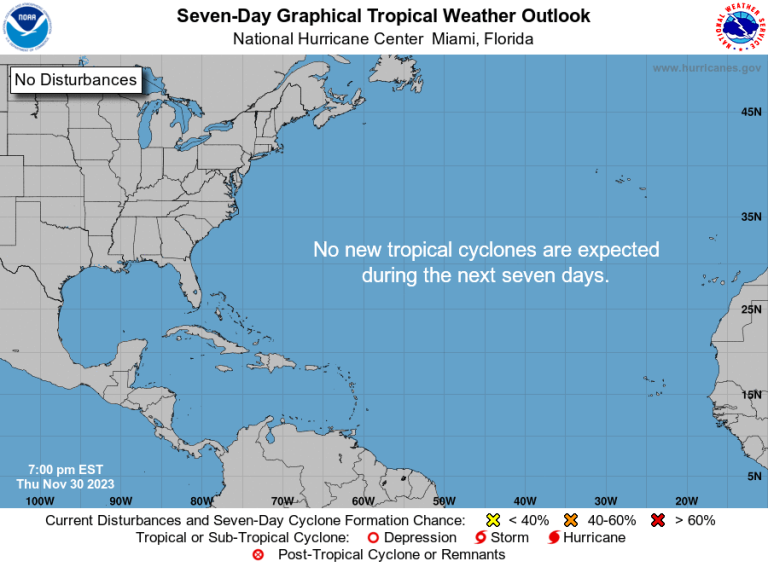The busy 2023 Atlantic hurricane season shows no signs of stopping.
Far out in the open Atlantic Ocean, about 1,400 miles off the East Coast, Hurricane Nigel continued to strengthen Tuesday morning. It is the fifth hurricane of the season and is expected to reach Category 2 status early Wednesday.
Fortunately, the hurricane's projected path shows it bending seaward long before it approaches the shores of the United States.
Although Nigel was the only active storm on Tuesday, the National Hurricane Center was cautiously monitoring two other systems developing in the Atlantic Ocean, including one near the coast of the southeastern United States.
Where is Cyclone Nigel located?
As of Tuesday morning, the center of Hurricane Nigel was located 630 miles east of Bermuda and was moving to the north-northwest at 16 mph, the hurricane center said. Maximum sustained winds were 90 mph, making it a Category 1 hurricane on the Saffir-Simpson Hurricane Intensity Scale.
“Nigel is expected to strengthen early Wednesday, with weakening possible Thursday and Friday,” the hurricane center said. “Nigel is forecast to become a powerful post-tropical cyclone on Friday.”
The hurricane is expected to turn northward late Tuesday, then rapidly accelerate northeastward through the rest of the week.
The forecast path of Cyclone Nigel
Special note about the NHC cone: The forecast track shows the most likely path of the storm's center. It does not show the full width of the storm or its effects, and the center of the storm is likely to move outside the cone up to 33% of the time.
Spaghetti models of Hurricane Nigel
Special note about spaghetti models: Illustrations involve a range of forecasting tools and models, and not all of them are created equal. The Hurricane Center uses only the four or five top-performing models to help make its forecasts.
Forecaster tracking system near the southeast coast
“A non-tropical low pressure area is expected to form near the southeastern coast of the United States late this week,” the Hurricane Center said. “This system could gain some subtropical characteristics this weekend if it stays offshore while slowly moving toward the north or northwest.”
The system “could bring gusty winds, heavy rain and high surf conditions to parts of the coastal Carolinas to coastal mid-Atlantic states this weekend,” the hurricane center said.
Meteorologist Jeff Masters of Yale Climate Connections wrote Monday that “regardless of development, the system will likely bring heavy rain to the coast; NOAA's forecast calls for 2 to 5 inches of rain along the coast from northern Florida to Virginia by “Next Monday. Coastal flooding caused by a prolonged period of strong onshore winds will also be a concern.”
the National Weather Service Jacksonville Residents warned Marine and coastal risks Along the coast and Intracoastal Waterway Thursday through Saturday if a low pressure system develops offshore.
Winds of 30 to 40 mph are likely, along with 5- to 8-foot breakers. Residents can see dangerous seas, tidal flooding and beach erosion.

A tropical wave is about to emerge from Africa
Meteorologists said a tropical wave is expected to move off the west coast of Africa by Wednesday.
“Environmental conditions are expected to be favorable for gradual wave development thereafter, and a tropical depression will likely form late this week or this weekend as the system moves westward across the eastern and central tropical Atlantic,” the Hurricane Center said. The system has a 70% chance of developing by the first part of next week.
“Initial indicators indicate that this wave will take a path far enough to the northwest to avoid the Caribbean islands, but it is too early to trust these forecasts,” Masters said on Monday.
The next two names on the list of Atlantic hurricane names are Ophelia and Philip. Which of the two systems develops first will be called Ophelia, while the other will be called Philip.

A tropical depression forms in the Pacific Ocean
Meanwhile, in the eastern Pacific Ocean on Tuesday, a new tropical depression formed Tuesday morning. The depression was located 805 miles southwest of the southern tip of Baja California, Mexico, and was moving to the west-northwest at 13 mph. It is expected to strengthen into Tropical Storm Kenneth later Tuesday.
The system does not pose any threat to any land area as it is expected to weaken and swirl into the sea by later in the week.
Contributing: Cheryl McCloud, USA TODAY Network – Florida


